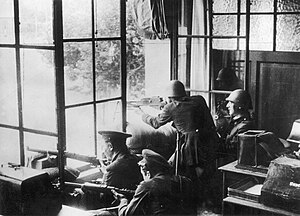
Back انقلاب يوليو 1936 في إسبانيا Arabic Путч у Іспаніі (1936) BE Опит за държавен преврат в Испания (1936) Bulgarian Taol-Stad Gouhere 1936 e Spagn BR Cop d'estat del 18 de juliol Catalan Puĉo de la 17-a kaj la 18-a de julio 1936 EO Golpe de Estado en España de julio de 1936 Spanish 1936ko uztaileko Espainiako estatu-kolpea EU Soulèvement nationaliste des 17 et 18 juillet 1936 en Espagne French Golpe de Estado do 18 de xullo de 1936 GL
| Spanish coup of July 1936 | |||||||
|---|---|---|---|---|---|---|---|
| Part of the Spanish Civil War | |||||||
 Republican soldiers and Assault Guards fighting in Barcelona during the uprising | |||||||
| |||||||
| Belligerents | |||||||
|
|
| ||||||
| Commanders and leaders | |||||||
|
|
| ||||||
The Spanish coup of July 1936[nb 1] was a military uprising that was intended to overthrow the Spanish Second Republic but precipitated the Spanish Civil War; Nationalists fought against Republicans for control of Spain. The coup was organized for 18 July 1936, although it started the previous day in Spanish Morocco. Instead of resulting in a prompt transfer of power, the coup split control of the Spanish military and territory roughly in half. The resulting civil war ultimately led to the establishment of a nationalist regime under Francisco Franco, who became ruler of Spain as caudillo.
The rising was intended to be swift, but the government retained control of most of the country including Málaga, Jaén and Almería. Cádiz was taken by the rebels, and General Gonzalo Queipo de Llano managed to secure Seville. In Madrid, the rebels were hemmed into the Montaña barracks, which fell with much bloodshed. On 19 July, the cabinet headed by the newly appointed prime minister José Giral ordered the distribution of weapons to the unions.[1] With the defeat of the rebels in Madrid, Barcelona, and Valencia, anarchists took control of large parts of Aragon and Catalonia. The rebel General Goded surrendered in Barcelona and was later sentenced to death and executed. The rebels secured the support of around half of the Spanish Army, which totalled about 66,000 men, including large numbers who were on leave, as well as the 30,000-strong army of Africa.[2] The army of Africa was Spain's most professional and capable military force. The government retained less than half the supply of rifles, heavy and light machine guns and artillery pieces. Both sides had few tanks and outdated aircraft, while naval capacity was reasonably even. The defection of many regular officers weakened Republican units of all types.
Cite error: There are <ref group=nb> tags on this page, but the references will not show without a {{reflist|group=nb}} template (see the help page).
- ^ Thomas, Hugh (2003). The Spanish Civil War. Penguin. p. 219. ISBN 0-141-01161-0.
- ^ Thomas 2003, p. 315.